Biodiversity Brochures
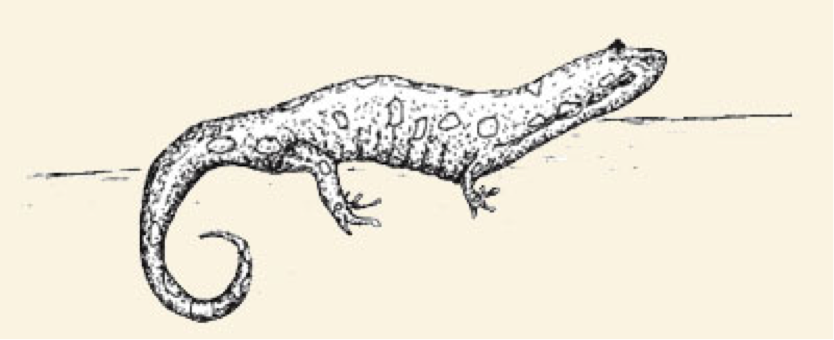 The Sewanee Herbarium produces a series of brochures to inform the curious observer about the living things with which we share our mountain -tio home. You can learn about our common vascular plants, amphibians, and birds.
The Sewanee Herbarium produces a series of brochures to inform the curious observer about the living things with which we share our mountain -tio home. You can learn about our common vascular plants, amphibians, and birds.
- FERNS
- FROGS, TOADS, AND SALAMANDERS
- COMMON BIRDS
- NUTS AND ACORN
- PLANTS OF PONDS AND SHORE
- SPRING FLORA OF SHAKERAG HOLLOW
- TREES
- BIG TREES
Ferns
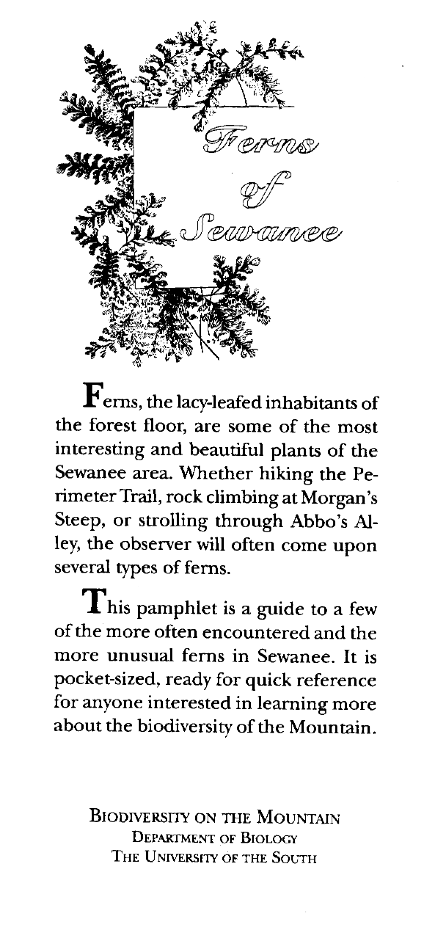 Ferns, the lacy-leafed inhabitants of the forest floor, are some of the most interesting and beautiful plants of the Sewanee area. Whether hiking the Perimeter Trail, rock climbing at Morgan's Steep, or strolling through Abbo's AIley, the observer will often come upon several types of ferns.
Ferns, the lacy-leafed inhabitants of the forest floor, are some of the most interesting and beautiful plants of the Sewanee area. Whether hiking the Perimeter Trail, rock climbing at Morgan's Steep, or strolling through Abbo's AIley, the observer will often come upon several types of ferns.
This pamphlet is a guide to a few of the more often encountered and the more unusual ferns in Sewanee. It is pocket-sized, ready for quick reference for anyone interested in learning more about the biodiversity of the Mountain.
Ferns of Sewanee brochure
Frogs, Toads, and Salamanders
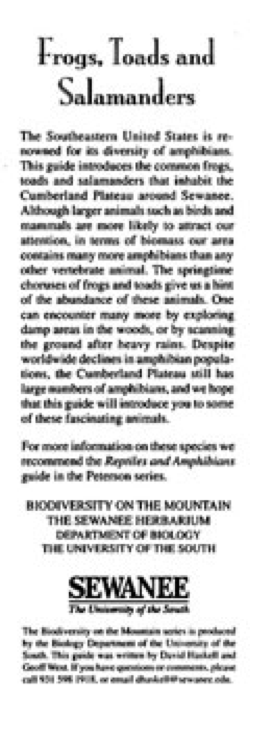 The Southeastern United States is renowned for its diversity of amphibians. This guide introduces the common frogs, toads and salamanders that inhabit the Cumberland Plateau around Sewanee. Although larger animals such as birds and mammals are more likely to attract our attention, in terms of biomass our area contains many more amphibians than any other vertebrate animal. The springtime choruses of frogs and toads give us a hint
The Southeastern United States is renowned for its diversity of amphibians. This guide introduces the common frogs, toads and salamanders that inhabit the Cumberland Plateau around Sewanee. Although larger animals such as birds and mammals are more likely to attract our attention, in terms of biomass our area contains many more amphibians than any other vertebrate animal. The springtime choruses of frogs and toads give us a hint
of the abundance of these animals. One can encounter many more by exploring damp areas in the woods, or by scanning the ground after heavy rains. Despite worldwide declines in amphibian populations, the Cumberland Plateau still has large numbers of amphibians, and we hope that this guide will introduce you to some of these fascinating animals.
Frogs, Toads, and Salamanders brochure
Common Birds
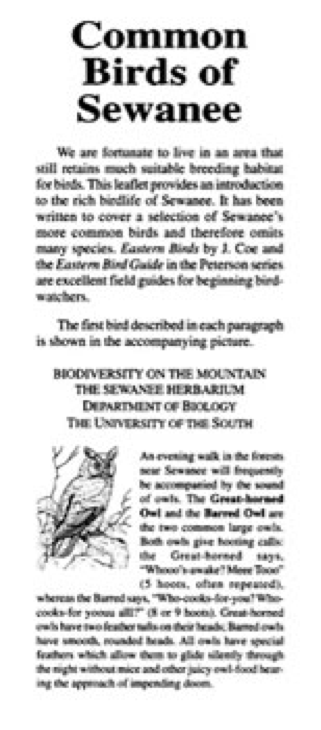 We are fortunate to live in an area that still retains much suitable breeding habitat for birds. This leaflet provides an introduction to the rich birdlife of Sewanee. It has been written to cover a selection of Sewanee's more common birds and therefore omits many species.
We are fortunate to live in an area that still retains much suitable breeding habitat for birds. This leaflet provides an introduction to the rich birdlife of Sewanee. It has been written to cover a selection of Sewanee's more common birds and therefore omits many species.
Common Birds of Sewanee brochure
Nuts and Acorn
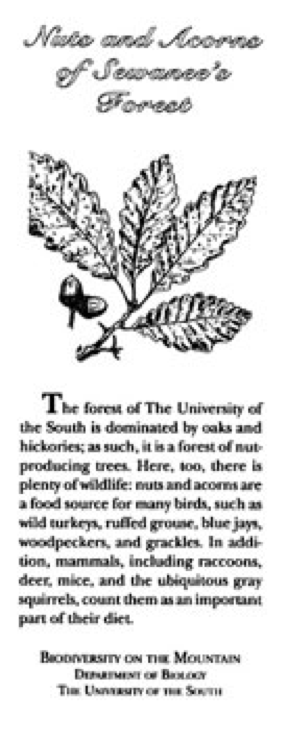 The forest of The University of the South is dominated by oaks and hickories; as such, it is a forest of nut-producing trees. Here, too, there is plenty of wildlife: nuts and acorns are a food source for many birds, such as wild turkeys, ruffed grouse, bluejays, woodpeckers, and grackles. In addition, mammals, including raccoons, deer, mice, and the ubiquitous gray squirrels, count them as an important part of their diet.
The forest of The University of the South is dominated by oaks and hickories; as such, it is a forest of nut-producing trees. Here, too, there is plenty of wildlife: nuts and acorns are a food source for many birds, such as wild turkeys, ruffed grouse, bluejays, woodpeckers, and grackles. In addition, mammals, including raccoons, deer, mice, and the ubiquitous gray squirrels, count them as an important part of their diet.
Nuts and Acorns of Sewanee's Forest brochure
Plants of Ponds and Shore
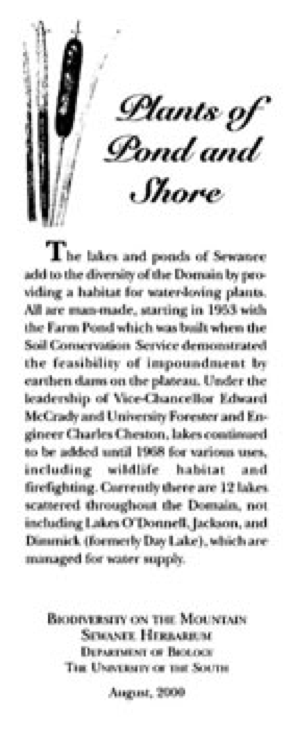 The lakes and ponds of Sewanee add to the diversity of the Domain by providing a habitat for water-loving plants. All are man-made, starting in 1953 with the Farm Pond which was built when the Soil Conservation Service demonstrated the feasibility of impoundment by earthen dams on the plateau. Under the leadership of Vice-Chancellor Edward McCrady and University Forester and Engineer Charles Cheston, lakes continued
The lakes and ponds of Sewanee add to the diversity of the Domain by providing a habitat for water-loving plants. All are man-made, starting in 1953 with the Farm Pond which was built when the Soil Conservation Service demonstrated the feasibility of impoundment by earthen dams on the plateau. Under the leadership of Vice-Chancellor Edward McCrady and University Forester and Engineer Charles Cheston, lakes continued
to be added until 1968 for various uses, including wildlife habitat and firefighting. Currently there are 12 lakes scattered throughout the Domain, not including Lakes O'Donnell, Jackson, and Dimmick (formerly Day Lake), which are managed for water supply.
Plants of Ponds and Shore brochure
Spring Flora of Shakerag Hollow
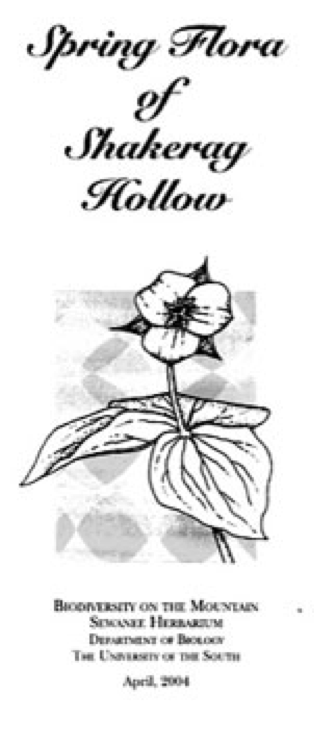 Take a walk through Shakerag Hollow, a forested area just off Green’s View that has remained virtually undisturbed by humans and is one of the most popular areas on the Domain of the University of the South for botanists and wildflower enthusiasts. The two-mile walk extends from the University gates on the eastern end of campus to Green’s View. On either end, the trail enters a forest typical of the Cumberland Plateau: the soil on the Plateau, derived from sandstone bedrock, is relatively poor and dry. The forest is of the “mixed oak” or “oak-hickory” type. It is a forest of nut producing trees, and the acorns and hickory nuts attract much wildlife. The understory is well-developed, with sassafras and dogwood trees, along with blueberry and mountain laurel shrubs.
Take a walk through Shakerag Hollow, a forested area just off Green’s View that has remained virtually undisturbed by humans and is one of the most popular areas on the Domain of the University of the South for botanists and wildflower enthusiasts. The two-mile walk extends from the University gates on the eastern end of campus to Green’s View. On either end, the trail enters a forest typical of the Cumberland Plateau: the soil on the Plateau, derived from sandstone bedrock, is relatively poor and dry. The forest is of the “mixed oak” or “oak-hickory” type. It is a forest of nut producing trees, and the acorns and hickory nuts attract much wildlife. The understory is well-developed, with sassafras and dogwood trees, along with blueberry and mountain laurel shrubs.
The trail was constructed in the 1930s by the Civilian Conservation Corps. As it descends into Shakerag Hollow, there is a marked change in species composition: some of the larger trees here include buckeye, basswood, and sugar maple. This is a cove hardwood forest, an area known for its high species diversity. Here, the bedrock is limestone, or calcium carbonate, which is rich in plant nutrients. In addition, the soil on this north-facing slope is more moist than that on top of the plateau.
Sewanee is blessed with beautiful woodlands, and the springtime flora is truly spectacular. The following list includes the trailside flowers that you are likely to come across in Shakerag. It is not an exhaustive checklist on the flora of the area. Picking flowers and digging plants in Shakerag are prohibited. Enjoy the wildflowers in their natural surroundings.
Spring Flora of Shakerag Hollow
Trees
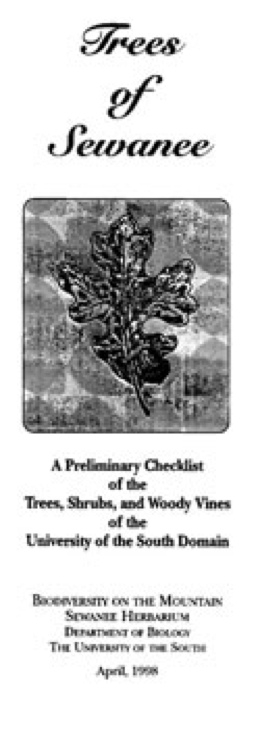 This list includes Sewanee's native and naturalized woody plants. Introduced species that have not naturalized are excluded.
This list includes Sewanee's native and naturalized woody plants. Introduced species that have not naturalized are excluded.
Trees of Sewanee brochure
Big Trees
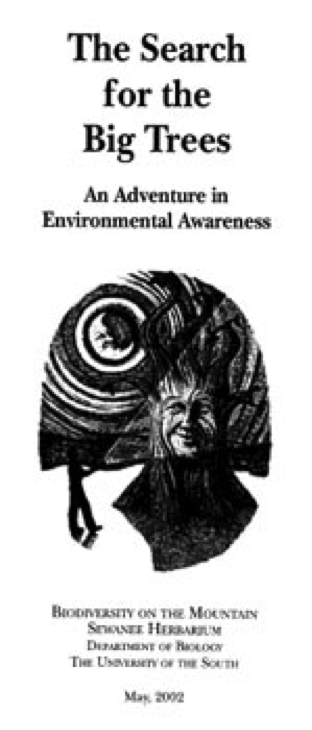 The adventure:
The adventure:
To find the answers to these questions....
-How many tree species do we have in our area?
-What is the largest tree of each species?
-What is the very largest tree in our area?
-Where are these trees located?
-Why are these trees important?
Big Trees of Sewanee brochure

